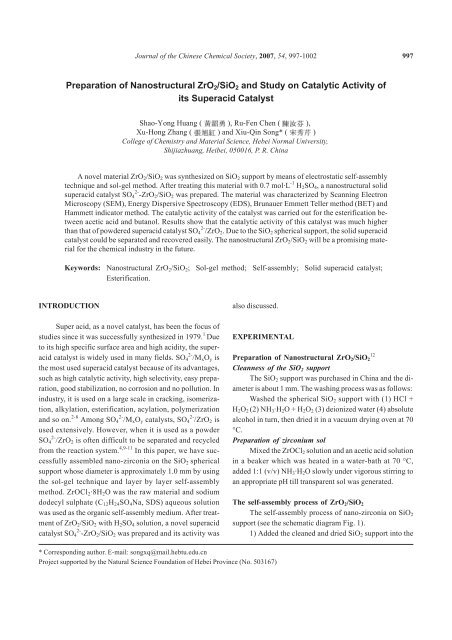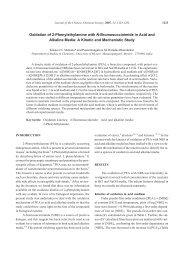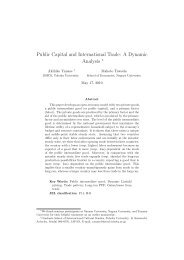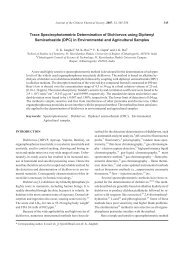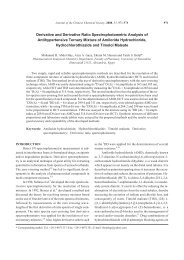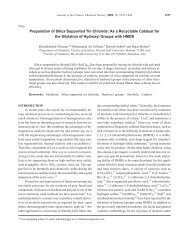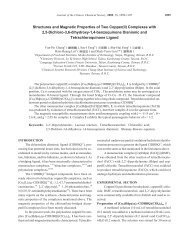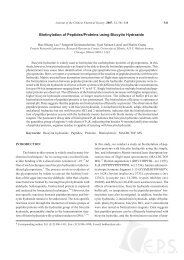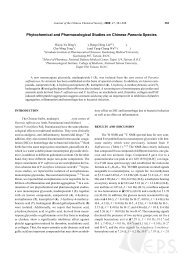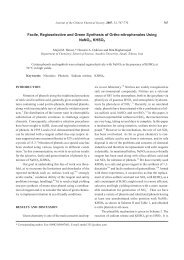Preparation of Nanostructural ZrO2/SiO2 and Study on Catalytic ...
Preparation of Nanostructural ZrO2/SiO2 and Study on Catalytic ...
Preparation of Nanostructural ZrO2/SiO2 and Study on Catalytic ...
You also want an ePaper? Increase the reach of your titles
YUMPU automatically turns print PDFs into web optimized ePapers that Google loves.
<str<strong>on</strong>g>Preparati<strong>on</strong></str<strong>on</strong>g> <str<strong>on</strong>g>of</str<strong>on</strong>g> <str<strong>on</strong>g>Nanostructural</str<strong>on</strong>g> <str<strong>on</strong>g>ZrO2</str<strong>on</strong>g>/<str<strong>on</strong>g>SiO2</str<strong>on</strong>g> <str<strong>on</strong>g>and</str<strong>on</strong>g> <str<strong>on</strong>g>Study</str<strong>on</strong>g> <strong>on</strong> <strong>Catalytic</strong> Activity <str<strong>on</strong>g>of</str<strong>on</strong>g><br />
its Superacid Catalyst<br />
Shao-Y<strong>on</strong>g Huang ( ), Ru-Fen Chen ( ),<br />
Xu-H<strong>on</strong>g Zhang ( ) <str<strong>on</strong>g>and</str<strong>on</strong>g> Xiu-Qin S<strong>on</strong>g* ( )<br />
College <str<strong>on</strong>g>of</str<strong>on</strong>g> Chemistry <str<strong>on</strong>g>and</str<strong>on</strong>g> Material Science, Hebei Normal University,<br />
Shijiazhuang, Heibei, 050016, P. R. China<br />
A novel material <str<strong>on</strong>g>ZrO2</str<strong>on</strong>g>/<str<strong>on</strong>g>SiO2</str<strong>on</strong>g> was synthesized <strong>on</strong> <str<strong>on</strong>g>SiO2</str<strong>on</strong>g> support by means <str<strong>on</strong>g>of</str<strong>on</strong>g> electrostatic self-assembly<br />
technique <str<strong>on</strong>g>and</str<strong>on</strong>g> sol-gel method. After treating this material with 0.7 mol·L -1 H2SO4, a nanostructural solid<br />
superacid catalyst SO4 2- -<str<strong>on</strong>g>ZrO2</str<strong>on</strong>g>/<str<strong>on</strong>g>SiO2</str<strong>on</strong>g> was prepared. The material was characterized by Scanning Electr<strong>on</strong><br />
Microscopy (SEM), Energy Dispersive Spectroscopy (EDS), Brunauer Emmett Teller method (BET) <str<strong>on</strong>g>and</str<strong>on</strong>g><br />
Hammett indicator method. The catalytic activity <str<strong>on</strong>g>of</str<strong>on</strong>g> the catalyst was carried out for the esterificati<strong>on</strong> between<br />
acetic acid <str<strong>on</strong>g>and</str<strong>on</strong>g> butanol. Results show that the catalytic activity <str<strong>on</strong>g>of</str<strong>on</strong>g> this catalyst was much higher<br />
than that <str<strong>on</strong>g>of</str<strong>on</strong>g> powdered superacid catalyst SO4 2- /<str<strong>on</strong>g>ZrO2</str<strong>on</strong>g>. Due to the <str<strong>on</strong>g>SiO2</str<strong>on</strong>g> spherical support, the solid superacid<br />
catalyst could be separated <str<strong>on</strong>g>and</str<strong>on</strong>g> recovered easily. The nanostructural <str<strong>on</strong>g>ZrO2</str<strong>on</strong>g>/<str<strong>on</strong>g>SiO2</str<strong>on</strong>g> will be a promising material<br />
for the chemical industry in the future.<br />
Keywords: <str<strong>on</strong>g>Nanostructural</str<strong>on</strong>g> <str<strong>on</strong>g>ZrO2</str<strong>on</strong>g>/<str<strong>on</strong>g>SiO2</str<strong>on</strong>g>; Sol-gel method; Self-assembly; Solid superacid catalyst;<br />
Esterificati<strong>on</strong>.<br />
INTRODUCTION<br />
Super acid, as a novel catalyst, has been the focus <str<strong>on</strong>g>of</str<strong>on</strong>g><br />
studies since it was successfully synthesized in 1979. 1 Due<br />
to its high specific surface area <str<strong>on</strong>g>and</str<strong>on</strong>g> high acidity, the superacid<br />
catalyst is widely used in many fields. SO4 2- /MxOy is<br />
the most used superacid catalyst because <str<strong>on</strong>g>of</str<strong>on</strong>g> its advantages,<br />
such as high catalytic activity, high selectivity, easy preparati<strong>on</strong>,<br />
good stabilizati<strong>on</strong>, no corrosi<strong>on</strong> <str<strong>on</strong>g>and</str<strong>on</strong>g> no polluti<strong>on</strong>. In<br />
industry, it is used <strong>on</strong> a large scale in cracking, isomerizati<strong>on</strong>,<br />
alkylati<strong>on</strong>, esterificati<strong>on</strong>, acylati<strong>on</strong>, polymerizati<strong>on</strong><br />
<str<strong>on</strong>g>and</str<strong>on</strong>g> so <strong>on</strong>. 2-8 Am<strong>on</strong>g SO4 2- /MxOy catalysts, SO4 2- /<str<strong>on</strong>g>ZrO2</str<strong>on</strong>g> is<br />
used extensively. However, when it is used as a powder<br />
SO4 2- /<str<strong>on</strong>g>ZrO2</str<strong>on</strong>g> is <str<strong>on</strong>g>of</str<strong>on</strong>g>ten difficult to be separated <str<strong>on</strong>g>and</str<strong>on</strong>g> recycled<br />
from the reacti<strong>on</strong> system. 4,9-11 In this paper, we have successfully<br />
assembled nano-zirc<strong>on</strong>ia <strong>on</strong> the <str<strong>on</strong>g>SiO2</str<strong>on</strong>g> spherical<br />
support whose diameter is approximately 1.0 mm by using<br />
the sol-gel technique <str<strong>on</strong>g>and</str<strong>on</strong>g> layer by layer self-assembly<br />
method. ZrOCl2·8H2O was the raw material <str<strong>on</strong>g>and</str<strong>on</strong>g> sodium<br />
dodecyl sulphate (C12H24SO4Na, SDS) aqueous soluti<strong>on</strong><br />
was used as the organic self-assembly medium. After treatment<br />
<str<strong>on</strong>g>of</str<strong>on</strong>g> <str<strong>on</strong>g>ZrO2</str<strong>on</strong>g>/<str<strong>on</strong>g>SiO2</str<strong>on</strong>g> with H2SO4 soluti<strong>on</strong>, a novel superacid<br />
catalyst SO4 2- -<str<strong>on</strong>g>ZrO2</str<strong>on</strong>g>/<str<strong>on</strong>g>SiO2</str<strong>on</strong>g> was prepared <str<strong>on</strong>g>and</str<strong>on</strong>g> its activity was<br />
Journal <str<strong>on</strong>g>of</str<strong>on</strong>g> the Chinese Chemical Society, 2007, 54, 997-1002 997<br />
also discussed.<br />
EXPERIMENTAL<br />
* Corresp<strong>on</strong>ding author. E-mail: s<strong>on</strong>gxq@mail.hebtu.edu.cn<br />
Project supported by the Natural Science Foundati<strong>on</strong> <str<strong>on</strong>g>of</str<strong>on</strong>g> Hebei Province (No. 503167)<br />
<str<strong>on</strong>g>Preparati<strong>on</strong></str<strong>on</strong>g> <str<strong>on</strong>g>of</str<strong>on</strong>g> <str<strong>on</strong>g>Nanostructural</str<strong>on</strong>g> <str<strong>on</strong>g>ZrO2</str<strong>on</strong>g>/<str<strong>on</strong>g>SiO2</str<strong>on</strong>g> 12<br />
Cleanness <str<strong>on</strong>g>of</str<strong>on</strong>g> the <str<strong>on</strong>g>SiO2</str<strong>on</strong>g> support<br />
The <str<strong>on</strong>g>SiO2</str<strong>on</strong>g> support was purchased in China <str<strong>on</strong>g>and</str<strong>on</strong>g> the diameter<br />
is about 1 mm. The washing process was as follows:<br />
Washed the spherical <str<strong>on</strong>g>SiO2</str<strong>on</strong>g> support with (1) HCl +<br />
H2O2 (2) NH3·H2O+H2O2 (3) dei<strong>on</strong>ized water (4) absolute<br />
alcohol in turn, then dried it in a vacuum drying oven at 70<br />
C.<br />
<str<strong>on</strong>g>Preparati<strong>on</strong></str<strong>on</strong>g> <str<strong>on</strong>g>of</str<strong>on</strong>g> zirc<strong>on</strong>ium sol<br />
Mixed the ZrOCl2 soluti<strong>on</strong> <str<strong>on</strong>g>and</str<strong>on</strong>g> an acetic acid soluti<strong>on</strong><br />
in a beaker which was heated in a water-bath at 70 C,<br />
added 1:1 (v/v) NH3·H2O slowly under vigorous stirring to<br />
an appropriate pH till transparent sol was generated.<br />
The self-assembly process <str<strong>on</strong>g>of</str<strong>on</strong>g> <str<strong>on</strong>g>ZrO2</str<strong>on</strong>g>/<str<strong>on</strong>g>SiO2</str<strong>on</strong>g><br />
The self-assembly process <str<strong>on</strong>g>of</str<strong>on</strong>g> nano-zirc<strong>on</strong>ia <strong>on</strong> <str<strong>on</strong>g>SiO2</str<strong>on</strong>g><br />
support (see the schematic diagram Fig. 1).<br />
1) Added the cleaned <str<strong>on</strong>g>and</str<strong>on</strong>g> dried <str<strong>on</strong>g>SiO2</str<strong>on</strong>g> support into the
998 J. Chin. Chem. Soc., Vol. 54, No. 4, 2007 Huang et al.<br />
zirc<strong>on</strong>ium sol then treated it in the processes <str<strong>on</strong>g>of</str<strong>on</strong>g> ultrasound,<br />
aging, washing <str<strong>on</strong>g>and</str<strong>on</strong>g> drying. After the first self-assembly<br />
process, Zr(OH)4/<str<strong>on</strong>g>SiO2</str<strong>on</strong>g> was fabricated.<br />
2) Added Zr(OH)4/<str<strong>on</strong>g>SiO2</str<strong>on</strong>g> into a SDS soluti<strong>on</strong>, followed<br />
by ultras<strong>on</strong>ic dispersi<strong>on</strong> for 30 min, then filtrated,<br />
washed <str<strong>on</strong>g>and</str<strong>on</strong>g> dried it in turn. We called this product SDS/<br />
Zr(OH)4/<str<strong>on</strong>g>SiO2</str<strong>on</strong>g>.<br />
3) Added SDS/Zr(OH)4/<str<strong>on</strong>g>SiO2</str<strong>on</strong>g> into the zirc<strong>on</strong>ium sol<br />
then treated it with the processes <str<strong>on</strong>g>of</str<strong>on</strong>g> ultrasound, aging, washing,<br />
<str<strong>on</strong>g>and</str<strong>on</strong>g> drying.<br />
4) By repeating (2), (3) steps <str<strong>on</strong>g>and</str<strong>on</strong>g> calcining it at an appropriate<br />
temperature, we could prepare a multilayer selfassembly<br />
<str<strong>on</strong>g>ZrO2</str<strong>on</strong>g>/<str<strong>on</strong>g>SiO2</str<strong>on</strong>g> material.<br />
<str<strong>on</strong>g>Preparati<strong>on</strong></str<strong>on</strong>g> <str<strong>on</strong>g>of</str<strong>on</strong>g> <str<strong>on</strong>g>Nanostructural</str<strong>on</strong>g> Superacid Catalyst<br />
SO4 2- -<str<strong>on</strong>g>ZrO2</str<strong>on</strong>g>/<str<strong>on</strong>g>SiO2</str<strong>on</strong>g><br />
Firstly, dried the sample Zr(OH)4/<str<strong>on</strong>g>SiO2</str<strong>on</strong>g> at 110 C for<br />
6 h; Sec<strong>on</strong>dly, impregnated the Zr(OH)4/<str<strong>on</strong>g>SiO2</str<strong>on</strong>g> with 0.7<br />
mol·L -1 H2SO4 for 1 h; Thirdly, filtrated <str<strong>on</strong>g>and</str<strong>on</strong>g> dried it at 110<br />
C for 10 h. After calcined at 550 C for 3 h, the SO4 2- -<br />
<str<strong>on</strong>g>ZrO2</str<strong>on</strong>g>/<str<strong>on</strong>g>SiO2</str<strong>on</strong>g> superacid catalyst was prepared.<br />
Evaluati<strong>on</strong> <str<strong>on</strong>g>of</str<strong>on</strong>g> <strong>Catalytic</strong> Activity<br />
The activity <str<strong>on</strong>g>of</str<strong>on</strong>g> the so-prepared SO4 2- -<str<strong>on</strong>g>ZrO2</str<strong>on</strong>g>/<str<strong>on</strong>g>SiO2</str<strong>on</strong>g> catalyst<br />
was tested for the esterificati<strong>on</strong> reacti<strong>on</strong> between acetic<br />
acid <str<strong>on</strong>g>and</str<strong>on</strong>g> butanol. The catalytic activity was studied in a<br />
stirred batch reflux system at a temperature <str<strong>on</strong>g>of</str<strong>on</strong>g> 120 C. A<br />
three-necked flask equipped with a c<strong>on</strong>denser <str<strong>on</strong>g>and</str<strong>on</strong>g> a water<br />
knockout trap was charged with a certain amount <str<strong>on</strong>g>of</str<strong>on</strong>g> acetic<br />
acid (10 mL, 0.18 mol) <str<strong>on</strong>g>and</str<strong>on</strong>g> butanol (20 mL, 0.22 mol). The<br />
Fig. 1. The schematic diagram <str<strong>on</strong>g>of</str<strong>on</strong>g> the self-assembly processes.<br />
amount <str<strong>on</strong>g>of</str<strong>on</strong>g> SO4 2- -<str<strong>on</strong>g>ZrO2</str<strong>on</strong>g>/<str<strong>on</strong>g>SiO2</str<strong>on</strong>g> used in experiments was calculated<br />
from that <str<strong>on</strong>g>of</str<strong>on</strong>g> the powder superacid catalyst. We kept<br />
the zirc<strong>on</strong>ium c<strong>on</strong>tent equal to the powdered superacid catalyst.<br />
1gSO4 2- -<str<strong>on</strong>g>ZrO2</str<strong>on</strong>g>/<str<strong>on</strong>g>SiO2</str<strong>on</strong>g> catalyst was used in the experiments.<br />
Sufficient stirring <str<strong>on</strong>g>of</str<strong>on</strong>g> the mixture was applied to<br />
avoid external mass or heat transport limitati<strong>on</strong>s. The reacti<strong>on</strong><br />
temperature was maintained by means <str<strong>on</strong>g>of</str<strong>on</strong>g> a thermostatic<br />
oil bath in which the reactor was immersed. For comparis<strong>on</strong>,<br />
a powdered superacid catalyst SO4 2- -<str<strong>on</strong>g>ZrO2</str<strong>on</strong>g> was<br />
also prepared by the sol-gel method. In the experiment, the<br />
c<strong>on</strong>versi<strong>on</strong> <str<strong>on</strong>g>of</str<strong>on</strong>g> acetic acid can be regarded as the activity <str<strong>on</strong>g>of</str<strong>on</strong>g><br />
the catalyst. 13<br />
Formula is as follows:<br />
C<strong>on</strong>versi<strong>on</strong> ratio = (1 V1/V0) 100%<br />
In this formula: V0 denotes the original volume <str<strong>on</strong>g>of</str<strong>on</strong>g><br />
NaOH neutralizing the total acetic acid added to the reacti<strong>on</strong><br />
system; V1 represents the volume <str<strong>on</strong>g>of</str<strong>on</strong>g> NaOH neutralizing<br />
the acetic acid extracted from the reacti<strong>on</strong> device in the<br />
experiment.<br />
Characterizati<strong>on</strong> <str<strong>on</strong>g>of</str<strong>on</strong>g> the Catalyst <str<strong>on</strong>g>and</str<strong>on</strong>g> Reacti<strong>on</strong> Product<br />
The catalyst was characterized by SEM (HITACHI<br />
S-570), EDS (HOLAND EDAX PV-9900), BET (MICRO-<br />
MERITICS ASAP 2010, -196 C) <str<strong>on</strong>g>and</str<strong>on</strong>g> the Hammett indicator<br />
method. 14,15 The products were analyzed by Gas Chromatography<br />
(GC, Shanghai Tianmei 7890F, detector: FID,<br />
column: AT.SE-54 15 m, column temperature:100 C, injector<br />
temperature: 150 C).
<str<strong>on</strong>g>Preparati<strong>on</strong></str<strong>on</strong>g> <str<strong>on</strong>g>and</str<strong>on</strong>g> <str<strong>on</strong>g>Study</str<strong>on</strong>g> <strong>on</strong> Nano <str<strong>on</strong>g>ZrO2</str<strong>on</strong>g>/<str<strong>on</strong>g>SiO2</str<strong>on</strong>g> Catalyst J. Chin. Chem. Soc., Vol. 54, No. 4, 2007 999<br />
RESULTS AND DISCUSSION<br />
Fig. 2 shows the images for the samples <str<strong>on</strong>g>of</str<strong>on</strong>g> <str<strong>on</strong>g>SiO2</str<strong>on</strong>g> <str<strong>on</strong>g>and</str<strong>on</strong>g><br />
nanostructural <str<strong>on</strong>g>ZrO2</str<strong>on</strong>g>/<str<strong>on</strong>g>SiO2</str<strong>on</strong>g>. We can find an obvious difference<br />
between the surfaces <str<strong>on</strong>g>of</str<strong>on</strong>g> the samples before <str<strong>on</strong>g>and</str<strong>on</strong>g> after<br />
self-assembly. Fig. 2-a shows that there are many white<br />
protuberances <strong>on</strong> the surface <str<strong>on</strong>g>of</str<strong>on</strong>g> the <str<strong>on</strong>g>SiO2</str<strong>on</strong>g> support. According<br />
to the EDS pattern (result is not shown), we proposed<br />
that the white surface protuberances are some irregular<br />
<str<strong>on</strong>g>SiO2</str<strong>on</strong>g> particles b<strong>on</strong>ding to the surface <str<strong>on</strong>g>of</str<strong>on</strong>g> <str<strong>on</strong>g>SiO2</str<strong>on</strong>g> support. After<br />
self-assembly for 5 times (Fig. 2-b) the white surface protuberances<br />
were covered because <str<strong>on</strong>g>of</str<strong>on</strong>g> the adsorpti<strong>on</strong> <str<strong>on</strong>g>of</str<strong>on</strong>g> zirc<strong>on</strong>ium<br />
species <strong>on</strong> the support. From the SEM images, we<br />
also see that the zirc<strong>on</strong>ium species particles adsorbed <strong>on</strong><br />
the support are small <str<strong>on</strong>g>and</str<strong>on</strong>g> dense after self-assembly. The<br />
particle size <str<strong>on</strong>g>of</str<strong>on</strong>g> zirc<strong>on</strong>ium species is about 20 nm.<br />
Table 1. The zirc<strong>on</strong>ium c<strong>on</strong>tents <str<strong>on</strong>g>of</str<strong>on</strong>g> different <str<strong>on</strong>g>ZrO2</str<strong>on</strong>g>/<str<strong>on</strong>g>SiO2</str<strong>on</strong>g> layers<br />
layer 1 3 5 7 8 9 11<br />
Zr/wt 37.56 40.08 42.69 48.12 50.53 48.99 48.87<br />
The zirc<strong>on</strong>ium c<strong>on</strong>tent was measured by EDS. Table<br />
1 shows that the zirc<strong>on</strong>ium c<strong>on</strong>tent increased with the selfassembled<br />
times then it reached a maximum value. After<br />
this point, the zirc<strong>on</strong>ium c<strong>on</strong>tent remained c<strong>on</strong>stant. In<br />
some experiments the zirc<strong>on</strong>ium c<strong>on</strong>tent even declined<br />
with the self-assembled times. The results indicate that the<br />
self-assembly process has a kinetic equilibrium, that is, a<br />
given experimental c<strong>on</strong>diti<strong>on</strong> has its special kinetic equilibrium<br />
value. Fig. 3 shows that the zirc<strong>on</strong>ium c<strong>on</strong>tent<br />
reaches 50.53 wt after self-assembly 8 times which was<br />
the maximum c<strong>on</strong>tent in the experiments. In practice, the<br />
Fig. 2. SEM images <str<strong>on</strong>g>of</str<strong>on</strong>g> samples before <str<strong>on</strong>g>and</str<strong>on</strong>g> after self-assembly. a- before self-assembly, b- after self-assembly 5 times.<br />
Fig. 3. EDS pattern <str<strong>on</strong>g>of</str<strong>on</strong>g> <str<strong>on</strong>g>ZrO2</str<strong>on</strong>g>/<str<strong>on</strong>g>SiO2</str<strong>on</strong>g> self-assembled 8 times.
1000 J. Chin. Chem. Soc., Vol. 54, No. 4, 2007 Huang et al.<br />
Table 2. Acid strengths <str<strong>on</strong>g>of</str<strong>on</strong>g> the solid superacid<br />
Indicator<br />
pKa<br />
1<br />
-11.99<br />
2<br />
-12.14<br />
self-assembly process, which is c<strong>on</strong>trolled by many factors<br />
not <strong>on</strong>ly in dynamics <str<strong>on</strong>g>and</str<strong>on</strong>g> thermodynamics but also in colloid<br />
<str<strong>on</strong>g>and</str<strong>on</strong>g> interface, is very complex. So there are still much<br />
research that needs to be d<strong>on</strong>e to prepare higher zirc<strong>on</strong>ium<br />
c<strong>on</strong>tent nanostructural <str<strong>on</strong>g>ZrO2</str<strong>on</strong>g>/<str<strong>on</strong>g>SiO2</str<strong>on</strong>g>. The EDS pattern also<br />
proves the self-assembly process to be feasible.<br />
The acidity <str<strong>on</strong>g>of</str<strong>on</strong>g> the SO4 2- -<str<strong>on</strong>g>ZrO2</str<strong>on</strong>g>/<str<strong>on</strong>g>SiO2</str<strong>on</strong>g> sample was measured<br />
with the Hammett indicator method. Table 2 gives the<br />
acidity <str<strong>on</strong>g>of</str<strong>on</strong>g> the sample self-assembled 1 time. It shows that<br />
the novel superacid SO4 2- -<str<strong>on</strong>g>ZrO2</str<strong>on</strong>g>/<str<strong>on</strong>g>SiO2</str<strong>on</strong>g> had almost the same<br />
acidity as the powdered superacid SO4 2- /<str<strong>on</strong>g>ZrO2</str<strong>on</strong>g>.<br />
The catalytic activity <str<strong>on</strong>g>of</str<strong>on</strong>g> SO4 2- -<str<strong>on</strong>g>ZrO2</str<strong>on</strong>g>/<str<strong>on</strong>g>SiO2</str<strong>on</strong>g> was tested<br />
for the esterificati<strong>on</strong> reacti<strong>on</strong> <str<strong>on</strong>g>of</str<strong>on</strong>g> acetic acid <str<strong>on</strong>g>and</str<strong>on</strong>g> butanol.<br />
Results (Fig. 4) <str<strong>on</strong>g>of</str<strong>on</strong>g> the samples assembled 1,3,5 times(denoted<br />
as S-ZrSi1, S-ZrSi3, S-ZrSi5) indicate that the catalytic<br />
activities <str<strong>on</strong>g>of</str<strong>on</strong>g> these catalysts followed this order: S-<br />
ZrSi1 S-ZrSi3 S-ZrSi5. Am<strong>on</strong>g these catalysts, the catalytic<br />
activity <str<strong>on</strong>g>of</str<strong>on</strong>g> S-ZrSi1 was the best <str<strong>on</strong>g>and</str<strong>on</strong>g> the c<strong>on</strong>versi<strong>on</strong><br />
could reach 98.7 within 120 min. It is worth noting that<br />
the activities <str<strong>on</strong>g>of</str<strong>on</strong>g> all nanostructural superacid catalysts S-<br />
ZrSi1, S-ZrSi3 <str<strong>on</strong>g>and</str<strong>on</strong>g> S-ZrSi5 were better than the powder<br />
3<br />
-12.70<br />
4<br />
-13.16<br />
5<br />
-13.80<br />
6<br />
-14.52<br />
7<br />
-16.04<br />
SO 4 2- -<str<strong>on</strong>g>ZrO2</str<strong>on</strong>g>/SiO 2 <br />
SO 4 2- /<str<strong>on</strong>g>ZrO2</str<strong>on</strong>g> (Powder) <br />
“” color change clear, “” color change unclear<br />
1 m-methylnitrobenzene 2 nitrobenzene 3 p-nitrochloro-benzene 4 m-nitrochloro-benzene<br />
5 2,4-dinitrotoluene 6 2,4-dinitrfluorobenzene 7 1,3,5-trinitrotoluene<br />
Fig. 4. C<strong>on</strong>versi<strong>on</strong>s <str<strong>on</strong>g>of</str<strong>on</strong>g> the SO4 2- -<str<strong>on</strong>g>ZrO2</str<strong>on</strong>g>/<str<strong>on</strong>g>SiO2</str<strong>on</strong>g> catalysts<br />
with different assembly times. 1- catalyst selfassembled<br />
1 time; 2- catalyst self-assembled 3<br />
times; 3- catalyst self-assembled 5 times; 4powder<br />
catalyst; 5- no catalyst.<br />
superacid catalyst SO4 2- /<str<strong>on</strong>g>ZrO2</str<strong>on</strong>g>. Their c<strong>on</strong>versi<strong>on</strong>s were bey<strong>on</strong>d<br />
90% in all experiments. The experiment results also<br />
show that the catalytic activity decreased with the selfassembly<br />
times. In experiments, we just found a little difference<br />
in acidity am<strong>on</strong>g them. A possible explanati<strong>on</strong> for<br />
the activities decrease is that the specific surface area <str<strong>on</strong>g>of</str<strong>on</strong>g> the<br />
<str<strong>on</strong>g>ZrO2</str<strong>on</strong>g>/<str<strong>on</strong>g>SiO2</str<strong>on</strong>g> declines with the self-assembly times (See Table<br />
3). As we all know, when the superacid catalyst was<br />
prepared, the specific surface area became smaller than that<br />
<str<strong>on</strong>g>of</str<strong>on</strong>g> the precursor. We c<strong>on</strong>sider that the <str<strong>on</strong>g>ZrO2</str<strong>on</strong>g> particles are<br />
separated from each other (less agglomerati<strong>on</strong>, less b<strong>on</strong>ding)<br />
after the first self-assembly was given, so the catalyst<br />
had a higher specific surface area which resulted in the<br />
higher activity.<br />
The catalytic repeatability <str<strong>on</strong>g>of</str<strong>on</strong>g> the SO4 2- -<str<strong>on</strong>g>ZrO2</str<strong>on</strong>g>/<str<strong>on</strong>g>SiO2</str<strong>on</strong>g><br />
catalyst was tested by using S-ZrSi1 to catalyze the reacti<strong>on</strong><br />
for several runs. Fig. 5 shows that after the catalyst was<br />
used for the sec<strong>on</strong>d run, the catalytic activity was still bey<strong>on</strong>d<br />
93. The c<strong>on</strong>versi<strong>on</strong> declined sharply when the catalyst<br />
was used for the third time. This result is perhaps related<br />
to two aspects. On <strong>on</strong>e h<str<strong>on</strong>g>and</str<strong>on</strong>g>, water is a major influencing<br />
factor in catalytic activity. It deactivates the catalyst<br />
Fig. 5. C<strong>on</strong>versi<strong>on</strong>s <str<strong>on</strong>g>of</str<strong>on</strong>g> the SO4 2- -<str<strong>on</strong>g>ZrO2</str<strong>on</strong>g>/<str<strong>on</strong>g>SiO2</str<strong>on</strong>g> catalysts<br />
with different use times. 1- used 1 time; 2- used<br />
2 times; 3- used 3 times; 4- used 4 times; 5- used<br />
5 times.
<str<strong>on</strong>g>Preparati<strong>on</strong></str<strong>on</strong>g> <str<strong>on</strong>g>and</str<strong>on</strong>g> <str<strong>on</strong>g>Study</str<strong>on</strong>g> <strong>on</strong> Nano <str<strong>on</strong>g>ZrO2</str<strong>on</strong>g>/<str<strong>on</strong>g>SiO2</str<strong>on</strong>g> Catalyst J. Chin. Chem. Soc., Vol. 54, No. 4, 2007 1001<br />
Table 3. The surface specific areas <str<strong>on</strong>g>of</str<strong>on</strong>g> the samples<br />
Sample<br />
BET/m 2 ·g -1<br />
ZrO 2/SiO 2 assembled<br />
1 time<br />
by decreasing the active sites <str<strong>on</strong>g>of</str<strong>on</strong>g> the catalyst. On the other<br />
h<str<strong>on</strong>g>and</str<strong>on</strong>g>, the effect <str<strong>on</strong>g>of</str<strong>on</strong>g> specific surface area <strong>on</strong> the activity is<br />
also relevant. The explanati<strong>on</strong> is as follows. As we all know,<br />
the specific surface area <str<strong>on</strong>g>of</str<strong>on</strong>g> a traditi<strong>on</strong>al super acid catalyst<br />
prepared with powdered <str<strong>on</strong>g>ZrO2</str<strong>on</strong>g> declines in the processes <str<strong>on</strong>g>of</str<strong>on</strong>g><br />
catalyst preparati<strong>on</strong> <str<strong>on</strong>g>and</str<strong>on</strong>g> use. In the case <str<strong>on</strong>g>of</str<strong>on</strong>g> S-ZrSi1, it has a<br />
high specific surface area. However, the high specific surface<br />
area also makes it easy to adsorb the organic species <strong>on</strong><br />
the catalyst surface, which block the active sites <str<strong>on</strong>g>and</str<strong>on</strong>g> decrease<br />
the acid active centre numbers <str<strong>on</strong>g>of</str<strong>on</strong>g> the superacid. As a<br />
result, it decreases the catalytic activity <str<strong>on</strong>g>of</str<strong>on</strong>g> the superacid<br />
catalyst SO4 2- -<str<strong>on</strong>g>ZrO2</str<strong>on</strong>g>/<str<strong>on</strong>g>SiO2</str<strong>on</strong>g>. The catalytic activity could be<br />
partly recovered by washing the catalyst with ethanol or acet<strong>on</strong>e.<br />
16<br />
The reacti<strong>on</strong> products were analyzed by a GC measurement.<br />
As can be seen from Fig. 6, <strong>on</strong>ly two peaks appeared<br />
in the GC pattern. Compared to the retenti<strong>on</strong> time <str<strong>on</strong>g>of</str<strong>on</strong>g><br />
the st<str<strong>on</strong>g>and</str<strong>on</strong>g>ard substance (acetic acid 2.298, butanol 1.345,<br />
butyl acetate 2.182), we can c<strong>on</strong>clude that after reacti<strong>on</strong><br />
there are <strong>on</strong>ly two substances in the reacti<strong>on</strong> system: butanol<br />
<str<strong>on</strong>g>and</str<strong>on</strong>g> butyl acetate. In experiments, butanol was overdosed<br />
so in the GC pattern its peak appeared. That is to say,<br />
no by-products were formed in any experiments. All these<br />
indicated that the novel superacid catalyst SO4 2- -<str<strong>on</strong>g>ZrO2</str<strong>on</strong>g>/<str<strong>on</strong>g>SiO2</str<strong>on</strong>g><br />
can catalyze the reacti<strong>on</strong> successfully <str<strong>on</strong>g>and</str<strong>on</strong>g> the reacti<strong>on</strong> selectivity<br />
is 100%.<br />
Fig. 6. Gas chromatography <str<strong>on</strong>g>of</str<strong>on</strong>g> the catalytic products.<br />
(Catalyst: self-assembled 1 time; Reacti<strong>on</strong> temperature:<br />
120 C, Reacti<strong>on</strong> time: 120 min).<br />
ZrO 2/SiO 2 assembled<br />
3 times<br />
CONCLUSION<br />
We have successfully synthesized a novel nanostructural<br />
<str<strong>on</strong>g>ZrO2</str<strong>on</strong>g>/<str<strong>on</strong>g>SiO2</str<strong>on</strong>g> material by using the sol-gel technique <str<strong>on</strong>g>and</str<strong>on</strong>g><br />
layer by layer self-assembly method. After treatment with<br />
H2SO4 soluti<strong>on</strong>, a novel superacid catalyst was prepared.<br />
The experiment results show that this superacid catalyst<br />
has almost the same acidity as the traditi<strong>on</strong>al powdered<br />
superacid SO4 2- /<str<strong>on</strong>g>ZrO2</str<strong>on</strong>g>; however, the catalytic activity is<br />
higher than that <str<strong>on</strong>g>of</str<strong>on</strong>g> the powdered superacid catalyst SO4 2- /<br />
<str<strong>on</strong>g>ZrO2</str<strong>on</strong>g> used in the experiments. The significant characteristic<br />
<str<strong>on</strong>g>of</str<strong>on</strong>g> this novel superacid catalyst is that it can be used, separated<br />
<str<strong>on</strong>g>and</str<strong>on</strong>g> recovered more easily <str<strong>on</strong>g>and</str<strong>on</strong>g> c<strong>on</strong>veniently due to<br />
having a big support. Now, the research <str<strong>on</strong>g>of</str<strong>on</strong>g> this novel super<br />
acid catalyst is still in the beginning stage so there is further<br />
work to be d<strong>on</strong>e. This nanostructural <str<strong>on</strong>g>ZrO2</str<strong>on</strong>g>/<str<strong>on</strong>g>SiO2</str<strong>on</strong>g> material<br />
will play an increasingly important role in the green catalytic<br />
field in the future.<br />
Received February 24, 2006.<br />
REFERENCES<br />
ZrO 2/SiO 2 assembled<br />
5 times<br />
Powder ZrO 2<br />
455 413 380 96<br />
1. Hino, M.; Kobayashi, S.; Arata, K. J. Am. Chem. Soc. 1979,<br />
101, 6439.<br />
2. Alain, S.; Jean, S. Appl. Catal. A: Gen. 1999, 188, 155.<br />
3. Mishra, H. K.; Dalai, A. K.; Das, D. D. et al. J. Coll. Inter.<br />
Sci. 2004, 272, 378.<br />
4. Gore, R. B.; Thoms<strong>on</strong>, W. J. Appl. Catal. A: Gen. 1998, 168,<br />
23.<br />
5. Chen, X.; Xu, Z.; Okuhara, T. Appl. Catal. A: Gen. 1999,<br />
180, 261.<br />
6. Ebeid, F. M.; Ali, L. I. J. Chin. Chem. Soc. 1984, 31, 179.<br />
7. Arata, K.; Nakamura, H.; Shouji, M. Appl. Catal. A: Gen.<br />
2000, 197, 213.<br />
8. Arata, K.; Hino, M. Appl. Catal. 1990, 59, 197.<br />
9. Altiokka, M. R.; Citak, A. Appl. Catal. A: Gen. 2003, 239,<br />
141.<br />
10. Liu, W. T.; Tan, C. S. Liquid-Phase Ind. Eng. Chem. Res.<br />
2001, 40, 3281.
1002 J. Chin. Chem. Soc., Vol. 54, No. 4, 2007 Huang et al.<br />
11. Yadav, G. D.; Thathagar, M. B. React. Funct. Polym. 2002,<br />
52, 99.<br />
12. Chen, R.-F.; S<strong>on</strong>g, X.-Q. J. Chin. Chem. Soc. 2004, 51, 945.<br />
13. Hua, W.-M.; Chen, J.-M.; Gao, Z. Petrochem. Tech. 1995,<br />
24, 385.<br />
14. Corma, A. Chem. Rev. 1995, 95, 559.<br />
15. Taaruk, Ikougi. et al. Translated by Zheng L.-B. et al. New<br />
Solid Acid <str<strong>on</strong>g>and</str<strong>on</strong>g> Alkali <str<strong>on</strong>g>and</str<strong>on</strong>g> its Catalysis; Chem. Ind. Press:<br />
Beijing, 1992.<br />
16. Chen, S.-Z.; Luo, A.-M.; Yang, F.-W. Ind. Catal. 1994, 3, 12.


